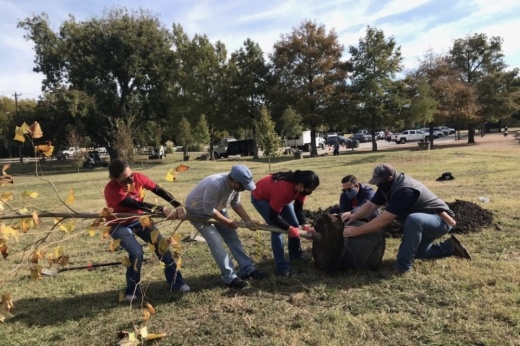The initiative is part of the Branch Out Dallas program, which was started in 2018 to reduce the heat island effect and increase the overall tree canopy in Dallas. Heat islands are urbanized areas that experience higher temperatures than outlying areas due to structures such as buildings and roads absorbing and re-emitting the sun’s heat more than natural landscapes would, according to the U.S. Environmental Protection Agency.
Dallas city forester Chris McMaster said the minimum requirement for the annual program is to plant at least 600 trees over the course of 12 tree-planting events. Since its inception, the program has exceeded that goal every year, even during the COVID-19 pandemic, he said.
“We were one of the few volunteer events that you could go to and get out of the house and do some good,” McMaster said.
The tree-planting events are volunteer driven, but city staff is in charge of digging the holes for the trees and installing irrigation systems, McMaster said. The city partners with the Texas Trees Foundation, which coordinates volunteers and funds 50% of the budget required to irrigate the new trees each year.
About 95% of the trees planted are native species with exceptions, such as pollinator-friendly trees, McMaster said. Each tree is considered 30 gallon, meaning they have a minimum trunk diameter of 2.5 inches and stand about 8 feet tall before they are planted.
Park sites are selected based on several criteria, including canopy coverage, open-space availability and equity. To ensure even distribution across the city, two parks are chosen from each of the city’s six maintenance districts, McMaster said.
The upcoming volunteer tree-planting events are as follows:
- Singing Hills Park on March 4
- Craddock Park on March 11
- Kensington Park on March 18
- Lochwood Park on March 25
- Park in the Woods Park on April 1
- R.P. Brooks Park on April 15
“It’s important to not have all your trees be the exact same age because then 40-50 years down the line, your trees are going to start failing all at once,” Wettengel said.
While having a positive environmental impact, planting trees around the city also provides various benefits to the community. Public green spaces can provide space for physical activity and social interaction while helping to mitigate mental illnesses, such as depression, according to a study published in the National Library of Medicine.
“For us to enrich and grow our green space that’s available for the citizenry is invaluable,” McMaster said.





